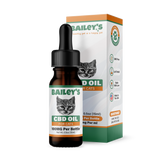Conjunctivitis in Cats: Feline Eye Condition

Conjunctivitis is a common eye condition that can affect cats of all ages and breeds. It is characterized by inflammation of the conjunctiva, which is the thin, clear tissue that covers the front surface of the eye and lines the inside of the eyelids.

This condition can cause discomfort and irritation for our feline friends, and the experts at Bailey’s CBD are here to help cat owners become knowledgeable about conjunctivitis, its causes, symptoms, diagnosis, treatment options, and preventive measures.
Table of Contents
1. Understanding Conjunctivitis in Cats
Conjunctivitis, also known as pink eye, is a common condition that affects cats. It is the inflammation of the conjunctiva, which is the thin, transparent tissue that covers the front surface of the eye and lines the inside of the eyelids. The conjunctiva acts as a protective barrier for the eyes, keeping them moist and trapping foreign particles. When it becomes inflamed, it can cause redness, swelling, and discharge.
Conjunctivitis in cats can be caused by various factors. Bacterial or viral infections are one of the most common causes. These infections can be transmitted from other cats or through contact with contaminated objects. Allergies can also trigger conjunctivitis in cats. Just like humans, cats can be allergic to certain substances such as pollen or dust mites, which can cause an allergic reaction in their eyes. Fungal infections can also lead to conjunctivitis in cats, although they are less common. Additionally, foreign bodies or irritants that come into contact with the eyes can cause inflammation. Finally, trauma to the eye, such as scratches or injuries, can result in conjunctivitis.
It's essential to determine the underlying cause of conjunctivitis in cats to provide appropriate treatment and prevent recurrence. The veterinarian will conduct a thorough examination of the cat's eyes and may perform additional tests, such as swabs or cultures, to identify the specific cause of the inflammation.
Several types of conjunctivitis can affect cats. Infectious conjunctivitis is caused by bacterial or viral infections. It is highly contagious and can spread easily among cats. Allergic conjunctivitis is triggered by allergens such as pollen or dust mites. Cats with allergies may experience seasonal flare-ups or have chronic symptoms. Eosinophilic conjunctivitis is a type of allergic conjunctivitis characterized by an allergic reaction involving eosinophilic inflammation. Eosinophils are a type of white blood cell that play a role in allergic responses. Fungal conjunctivitis is caused by fungal infections, which are less common but can occur in certain environments. Traumatic conjunctivitis is a result of eye injuries, such as scratches or foreign objects entering the eye.
Each type of conjunctivitis may require specific treatment approaches. For bacterial or viral conjunctivitis, antibiotics or antiviral medications may be prescribed. Allergic conjunctivitis can be managed with antihistamines or corticosteroids to reduce inflammation. Eosinophilic conjunctivitis may require a combination of medications to address the underlying allergic response. Fungal conjunctivitis may be treated with antifungal medications. Traumatic conjunctivitis often requires careful cleaning of the eye and may involve additional treatments, such as pain management or surgery if necessary. The veterinarian will determine the most suitable course of action based on the cat's condition.
2. Symptoms of Conjunctivitis in Cats
2.1 Physical Signs to Look Out For
When a cat is affected by conjunctivitis, there are several physical signs that owners should be vigilant for. These signs may include:
- Redness and inflammation of the conjunctiva
- Excessive tearing or watery eyes
- Thick discharge or pus
- Crusts or discharge building up around the eyes
- Squinting or blinking excessively
- Sensitivity to light
If you notice any of these symptoms, it is important to seek veterinary attention promptly to prevent further complications.
2.2 Behavioral Changes in Your Cat
In addition to physical signs, conjunctivitis can also cause behavioral changes in cats. Cats with conjunctivitis may exhibit:
- Decreased appetite
- Lethargy or decreased activity levels
- Desire to be left alone and avoid interaction

These changes in behavior are often due to the discomfort and pain associated with conjunctivitis, and it's important to provide supportive care and seek veterinary advice.
Conjunctivitis, also known as pink eye, is a common condition in cats. It occurs when the conjunctiva, the thin membrane that covers the front of the eye and lines the inside of the eyelids, becomes inflamed. This inflammation can be caused by a variety of factors, including viral or bacterial infections, allergies, irritants, or underlying health conditions.
When a cat develops conjunctivitis, the affected eye or eyes may appear red and swollen. The conjunctiva may also become irritated and produce excessive tears or watery discharge. In more severe cases, a thick discharge or pus may be present, leading to the formation of crusts around the eyes.
Aside from the physical signs, cats with conjunctivitis may also experience behavioral changes. Due to the discomfort and pain associated with the condition, cats may exhibit a decreased appetite and reduced activity levels. They may also prefer to be left alone and avoid interaction with their owners or other pets.
It's important to seek veterinary attention promptly if you notice any of these symptoms in your cat. Conjunctivitis can be uncomfortable for your feline friend and may lead to further complications if left untreated. A veterinarian will be able to determine the underlying cause of the conjunctivitis and recommend appropriate treatment options.
Treatment for conjunctivitis in cats may include topical medications, such as eye drops or ointments, to reduce inflammation and fight off any infection. In some cases, oral medications or additional supportive care may be necessary. It's crucial to follow your veterinarian's instructions and complete the full course of treatment to ensure a successful recovery.
While conjunctivitis can be a bothersome condition for cats, with proper veterinary care and supportive measures, most cases can be effectively managed and resolved. Providing a clean and comfortable environment for your cat, along with regular eye cleaning, can also help prevent the recurrence of conjunctivitis.
Remember, if you suspect that your cat may have conjunctivitis, don't delay in seeking veterinary attention. Early diagnosis and treatment are key to ensuring your furry friend's eye health and overall well-being.
3. Diagnosing Conjunctivitis in Cats
When diagnosing conjunctivitis in cats, a veterinarian will perform a thorough examination of the cat's eyes and overall health. This examination is crucial to accurately diagnose and treat the condition. Conjunctivitis, also known as pink eye, is the inflammation of the conjunctiva, the thin membrane that covers the inner surface of the eyelids and the white part of the eye.
3.1 Veterinary Examination Procedures
The examination may involve various procedures to assess the cat's eye health. The veterinarian will start by visually inspecting the eyes, eyelids, and surrounding areas. This allows them to identify any visible abnormalities or signs of infection.
In addition to the visual inspection, the veterinarian may also measure tear production. Tear production is an important factor in diagnosing conjunctivitis, as decreased tear production can contribute to the development of the condition. By measuring tear production, the veterinarian can determine if there is an underlying issue that needs to be addressed.
Furthermore, the veterinarian may use special dyes to detect corneal ulcers or abnormalities. These dyes are applied to the surface of the eye and can help identify any damage or irregularities that may be contributing to the conjunctivitis.
Based on the examination findings, the veterinarian may recommend further diagnostic tests to identify the underlying cause of conjunctivitis. Identifying the cause is crucial in order to provide effective treatment and prevent recurrence. Your feline friend’s favorite veterinarian is your best resource for treatments, recommended lifestyle adjustments, and any other diet or supplement changes.
3.2 Diagnostic Tests for Conjunctivitis
Common diagnostic tests for conjunctivitis in cats may include conjunctival scrapings or swabs to collect samples for bacterial or viral cultures. These cultures help identify the specific bacteria or virus responsible for the conjunctivitis, allowing for targeted treatment.
In addition to bacterial or viral cultures, testing for allergic reactions may also be performed. This can be done through intra-dermal or blood tests. Allergies can be a common cause of conjunctivitis in cats, and identifying the specific allergen can help in developing an appropriate treatment plan.
Fungal cultures may also be conducted to identify fungal infections that can cause conjunctivitis. Fungal infections are less common than bacterial or viral infections, but they can still occur and require specific treatment.
Furthermore, imaging tests such as X-rays or ultrasound may be used to assess the overall eye health. These tests can help identify any structural abnormalities or underlying conditions that may be contributing to conjunctivitis.
These diagnostic tests are essential in determining the cause of conjunctivitis and guiding the appropriate treatment plan. By identifying the underlying cause, veterinarians can provide targeted and effective treatment, ensuring the best possible outcome for the cat.
4. Treatment Options for Feline Conjunctivitis
4.1 Medication and Therapies
Treatment for conjunctivitis in cats depends on the underlying cause and severity of the condition. It may involve:
- Topical or oral antibiotics for bacterial conjunctivitis
- Antiviral medications for viral conjunctivitis
- Allergy management, including antihistamines or immunosuppressive drugs for allergic conjunctivitis
- Antifungal medications for fungal conjunctivitis
- Topical anti-inflammatory drugs to reduce inflammation and discomfort
Additionally, supportive care measures such as applying warm compresses, cleaning the affected area, and keeping the eyes clean can help alleviate symptoms and promote healing.
4.2 Home Care and Management
Owners play a vital role in the successful treatment and management of conjunctivitis in cats. It is essential to:
- Administer medications as prescribed
- Keep the cat's eyes clean and free of discharge
- Monitor for any changes or worsening of symptoms
- Follow up with the veterinarian for evaluation and adjustment of treatment
By providing proper care and following the veterinarian's instructions, owners can help their cats recover from conjunctivitis more effectively.

5. Preventing Conjunctivitis in Cats
5.1 Vaccination and its Role in Prevention
Vaccination plays a crucial role in preventing certain types of conjunctivitis in cats, such as viral conjunctivitis caused by feline herpesvirus or feline calicivirus. Regular vaccination protocols recommended by veterinarians can help protect cats from these infectious agents.
5.2 Hygiene Practices for Cat Owners
Practicing good hygiene is essential to prevent conjunctivitis in cats. Cat owners can minimize the risk by:
- Regularly cleaning the cat's litter box and environment
- Washing hands thoroughly before and after handling the cat
- Avoiding any potential irritants or harmful substances around the cat
- Keeping the cat's eyes clean and free of debris
By maintaining a clean and hygienic environment, cat owners can reduce the chances of conjunctivitis and promote the overall health and well-being of their feline companions.











